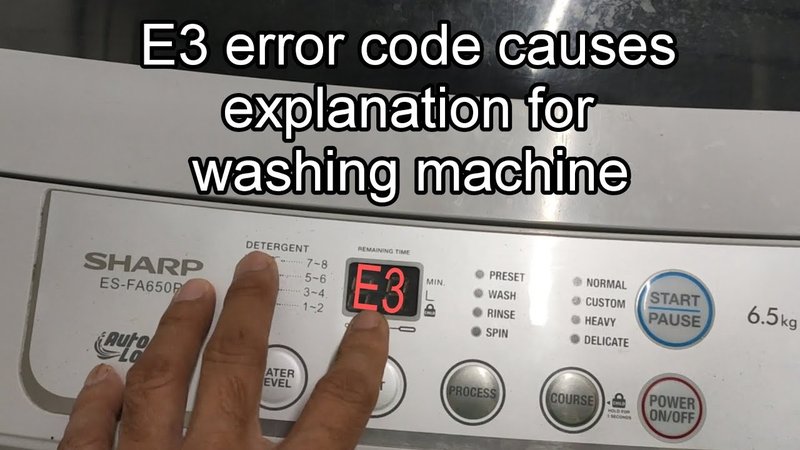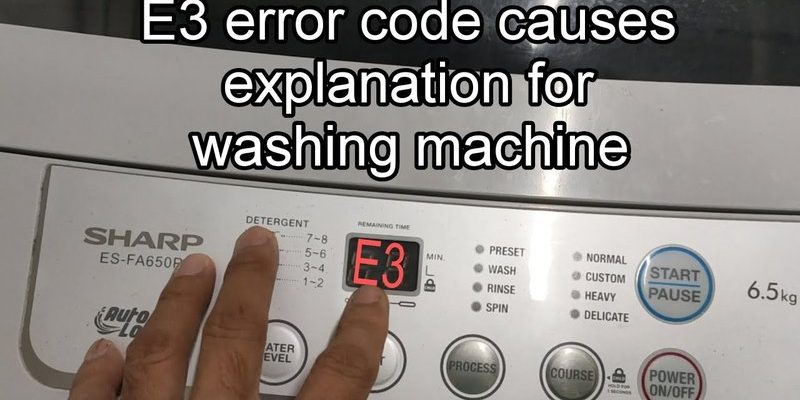
Think of your washing machine as a car dashboard, where the warning lights signal when something needs your attention. In a similar vein, washing machines have error codes to communicate specific issues. The E3 error code on a GE washing machine indicates a problem related to the machine’s water level sensing system. This could mean that your washer is not filling with water properly, or perhaps it’s overfilling. Before you panic, let’s break down the possible causes and solutions so you can get back to your laundry without hassle.
Understanding the Cause of Error Code E3
Here’s the deal: The E3 error can be a bit of a puzzler because it involves the water sensor system. Think of this system as the washing machine’s brain, sending signals about water levels much like how our senses tell us when it’s time to stop eating because we’re full. When this sensor malfunctions, it sends an E3 error code.
You might be wondering, “Why is this happening?” Well, it could be due to a clogged water inlet valve. Consider the water inlet valve as the machine’s way of drinking water. If something blocks the flow, it’s like sipping through a clogged straw — frustrating and ineffective. When the valve gets blocked by debris or mineral buildup, the machine struggles to fill with the right amount of water.
Another potential cause could be a kinked or clogged hose. Imagine trying to water plants with a garden hose that’s twisted—you’re not getting much water flow, right? Similarly, if the hose leading into your washing machine is kinked or blocked, it can’t deliver water efficiently, triggering the E3 code.
How to Troubleshoot and Fix the E3 Error Code
Don’t worry, most E3 errors are fixable with a little patience and know-how. First, check the water inlet hose. You’ll want to ensure it’s not kinked or obstructed in any way. Straighten it out and clear any visible blockages. This simple fix could resolve the issue and get you back to washing in no time.
Next, inspect the water inlet valve itself. Turn off your washing machine and disconnect the power. Carefully remove the valve to examine it. If you spot any debris or calcium deposits, gently clean it. Much like cleaning a coffee maker to improve water flow, this can enhance the machine’s performance.
If these steps don’t work, it might be the water level sensor that needs attention. This sensor is the unsung hero of your washing machine, gauging how much water should be in the drum. If it’s faulty, consider consulting the GE service manual or calling a professional. It’s always a good idea to have expert assistance if you’re unsure.
Preventing Future E3 Errors
Wouldn’t it be great to avoid these kinds of interruptions altogether? While you can’t predict every machine hiccup, you can certainly reduce the chances of seeing that E3 error code again. Start by regularly inspecting and cleaning out the water inlet valve and hose. Think of it as preventative maintenance, much like rotating your car tires to ensure even wear.
Moreover, using water softeners can help prevent mineral buildup in your machine. Just like how a good conditioner keeps hair smooth and tangle-free, water softeners can ward off the stubborn mineral deposits that clog your washing machine’s insides.
Finally, running a cleaning cycle once a month can keep your washer in top shape. It’s like giving your washing machine a spa day, allowing it to rinse out any lingering soap scum and dirt. This simple task can effectively prolong the life of your appliance.
In a nutshell, the E3 error code is a call for attention from your GE washing machine, usually involving some hiccup with water filling. By understanding the causes and taking proactive steps, you can often resolve this issue swiftly. If troubleshooting at home doesn’t do the trick, reaching out to a professional ensures you’re not left high and dry. Keeping your washing machine in good condition can be hassle-free with consistent care, and familiarizing yourself with these solutions means you’ll be ready to tackle future laundry-day surprises.
